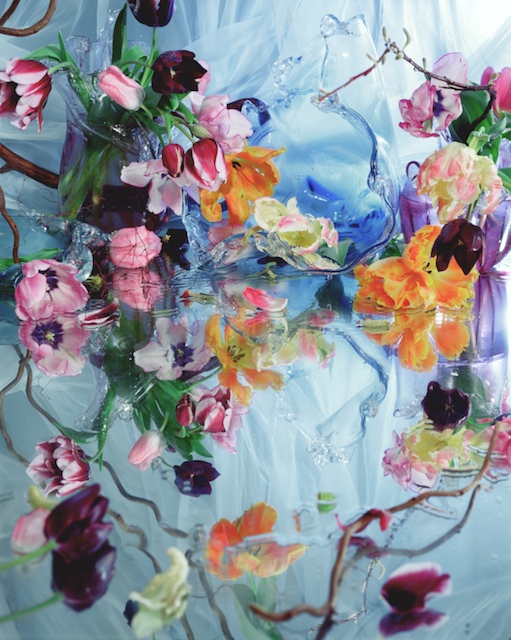Tulipomania
2004, Gallery Wäcker & Jordanow, Dr. Erika Wäcker, Munich

One could be forgiven for thinking that these photographs by Margriet Smulders (born 1955) were paintings: the splendid flower arrangements in brilliant shades of red and purple are so bountiful and baroque that they could almost be by the Old Masters themselves.
These still lifes by the Dutch artist, who is very well known in her own country but has never had a solo exhibition in Germany, were 'painted' with a camera. In these dense, dramatically staged compositions made up of flowers, blown glasses, reflecting mirrors and drops of water, the sumptuous diversity and passion of nature is evoked. These lavish images of flowers, proliferating from edge to edge of the picture and exhibiting the full range of forms and shades, oscillate between order and chaos, immobility and dynamism, thriving and decaying.
The entire Tulipomania series is devoted to tulips. Following winter, the tulip is one of the first signs of nature's reawakening, a symbol of fertility and thus also of sensuality and vitality. The tulip unfolds its beauty when in full bloom, but even the wilting tulip can be stubbornly inspiring. Margriet Smulders has been photographing flowers since 1996, initially as individual 'portraits', later as 'group photos' which became ever more spectacular and luxuriant, finding a temporary high point in her marvellous Siren series.
Margriet Smulders began to focus on the tulip in 2002, in the context of a large commissioned work for the Dutch embassy in Ankara. During the preparatory work for the 10 x 2.25 meter photograph inspired by Monet's Nympheas, she discovered the fascination of the many different new and old species of tulip. The tulip, which is mentioned in the Koran, symbolises the relations between Turkey and the Netherlands.
In the 2003 Tulipomania series Margriet Smulders continues her work with tulips. Through the colour and formal associations of the individual photographs she acknowledges artists such as Rembrandt, Matisse, Dufy, and also Pipilotti Rist and Bettina Rheims, whose works have inspired her in different ways. The arrangements in Margriet Smulders' works take up the tradition of Dutch still life painting, which reached its peak in the 17th century with masterful paintings of flowers. Those lush paintings were intended as a symbolic reminder of man's transience and earthly vanity.
When Smulders toys with this symbolism, she not only awakens associations such as with Baudelaire's Fleurs du Mal and their bombastic-erotic connotations, she also recalls the sexual symbolism of flower cups, and evokes the modern feminism of a Pipilotti Rist, who in her famous video breaks car windows with a flower. Margriet Smulders' wondrously impenetrable worlds, whose ingredients are ultimately the artist's secret, are staged and arranged solely for the camera. By deliberately using kitsch as a stylistic tool which she combines with a great sense of beauty and symbolic power, the artist arrives at self-confident and unconventional variations of a traditional genre. She thus produces photographs that have an almost hypnotic force, are confusing and seductive and engender a whole new visual experience.
Margriet Smulders first studied painting and drawing at the Academy of Fine Arts in Arnheim, before opting for photography. In the early 1990s she took her series of self-portraits in different roles and portraits in arranged settings. To this day, portrait photography plays an important role in her work. Works by Margriet Smulders are to be found in many public and private collections in the Netherlands as well as in Dutch foreign representations.
